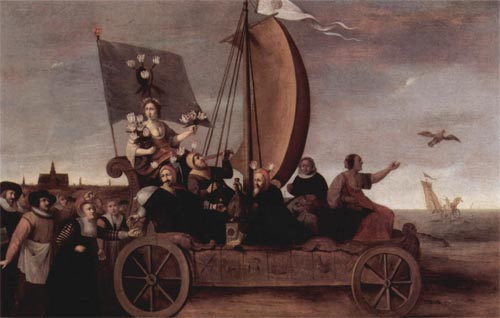Where speculation blossoms, beware of vanitas

“Flora’s Wagon of Fools” (1637) by Hendrick Gerritsz Pot. Oil on panel, 61 x 83 cm, Frans Hals Museum, Haarlem, The Netherlands.
플로라와 바보들의 수레 (1640), 헨드리크 포트 (1580-1657) 작, 61×83㎝, 프란츠 할스 박물관, 하를렘.
In my previous article about tulip mania, I discussed a satirical Flemish painting circa 1640 that depicts Dutch tulip speculators in the 1630s as stupid monkeys. The painting above is another satirical work made by Dutch painter Hendrick Gerritsz Pot (1580-1657) after the tulip bubble collapsed in 1637.
*tulip mania : 튤립 투기 광풍
*satirical painting : 풍자화
튤립 투기 광풍에 대한 지난 글에서 네덜란드 튤립 투기자들을 멍청한 원숭이로 묘사한 1640년께의 풍자화를 소개했었다. 여기, 1637년 튤립 거품이 붕괴된 직후에 네덜란드 화가 헨드리크 포트(1580~1657)가 그린 또 하나의 풍자화가 있다.
In the painting, the wagon of fools, runs down a stretch of beach with the wind filling its sail. On the wagon’s high throne sits Flora, the Roman goddess of flowers, under a flag adorned with tulips. She holds a bunch of valuable striped tulips, which were regarded by wealthy Dutch people as a must-have luxury item.
*with the wind filling its sail : 돛에 바람을 가득 안고
이 그림에서는 돛을 단 커다란 수레가 바람을 안고 해변을 달려간다. 수레 위 높은 자리에는 튤립으로 수놓인 깃발 아래 로마 신화 속 꽃의 여신 플로라가 앉아 있다. 여신의 품에는 네덜란드 부유층 사이에서 명품으로 각광받은 희귀한 줄무늬 튤립이 가득하다.
In the front of the wagon is a woman with two faces. According to the Frans Hals Museum, to which the painting belongs, she is the personification of vain hope. This must be the vain hope that tulip bulb prices would continue their mercurial ascent, because at that point, the purchase and resale of a single tulip bulb was highly profitable.
*personification : 의인화
*mercurial : 변덕스러운, 날뛰는
수레의 맨 앞에는 얼굴이 앞뒤로 하나씩 달린 여자가 앉아 있는데, 이 그림을 소장한 프란츠 할스 박물관에 따르면 헛된 희망을 상징한다고 한다. 아마도 그 헛된 희망이란 ‘튤립 값이 지금까지 올랐으니 앞으로도 오르겠지. 지금 사서 팔면 떼돈을 벌 수 있어!’일 것이다.
Behind the “Dame Vain Hope,” are three men wearing fools’ caps with tulips on their heads. They symbolize gluttony, avarice and loose talk, respectively according to the museum. Vain hope, avarice and empty tales are the driving forces behind the tulip mania depicted in this painting.
*gluttony : 탐식
*avarice : 탐욕
*loose talk : (허풍 섞인) 떠벌이는 말
*empty tale : 허풍
그 뒤로 어릿광대 복장을 하고 머리 양쪽에 튤립을 꽂은 남자 세 명이 있다. 박물관 관계자는 세 남자는 헛된 희망과 함께 튤립광풍을 일으킨 원동력인 탐욕과 허풍을 상징한다고 말했다.
In particular, Mr. Loose Talk, who seems to be telling tales about people who have profited from the tulip trade, extends a hand toward a throng of people who, tempted by his words, follow the wagon. The people are weavers from the city of Haarlem who have abandoned their work to walk behind the wagon, the museum explains.
*throng : 인파, 군중
*weaver : 직공
특히 배 끝에 앉은 남자는 ‘누구 누구가 튤립으로 떼돈 벌었다더라’ 하는 과장 섞인 소문을 떠벌리면서, 그 말에 솔깃해서 수레를 따라오는 사람들에게 손을 내밀고 있다. 이 사람들은 네덜란드 하를렘시의 직공들로서 생업도 팽개치고 수레를 뒤쫓고 있는 중이다.
This painting is a good representation of the tulip mania that overcame the Dutch city of Haarlem, which was at the center of the flower trade in 17th century Netherlands. The sudden rise in tulip prices must have led the weavers to believe they could become rich overnight.
*become reach overnight : 순식간에 부자가 되다,
일확천금을 얻다
이 그림은 꽃 거래의 중심 도시였던 하를렘의 튤립광풍을 잘 요약해서 보여준다. 팽창하는 가격 거품이 일확천금을 바라는 인간의 욕심을 부추겼으리라.
In the 1630s, the bulbs of rare striped tulips were sold for thousands of florins (or Dutch guilders). In particular, the prices of the bulbs surged by hundreds of florins overnight in late 1636 when the bubble was starting to peak.
*bubble : 거품, 여기서는 가격거품
1630년대에 희귀한 줄무늬 튤립은 몇천 플로린에 거래되었고, 특히 거품이 절정에 달한 1636년 말에는 자고 나면 몇백 플로린씩 가격이 뛰었다.
JoongAng Daily 7면 기사 Friday. Apr 30, 2010
번역:문소영 중앙데일리 문화생활스포츠팀장 (symoon@joongang.co.kr)










with the Korea JoongAng Daily
To write comments, please log in to one of the accounts.
Standards Board Policy (0/250자)